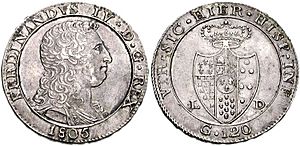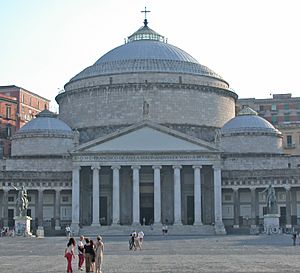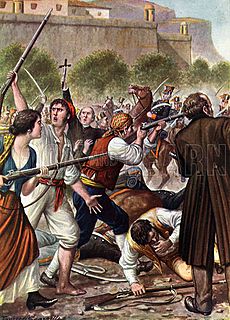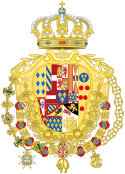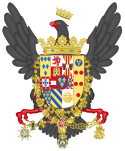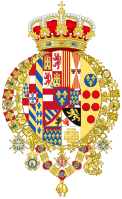Ferdinand I of the Two Sicilies facts for kids
Quick facts for kids Ferdinand I(IV / III) |
|||||
|---|---|---|---|---|---|
| Infante of Spain | |||||
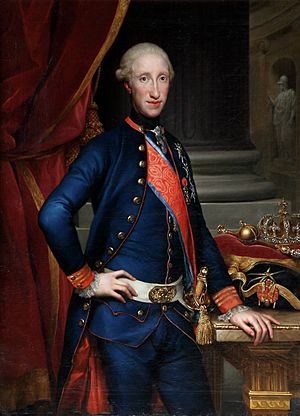
Portrait by Anton Raphael Mengs, c. 1772–1773
|
|||||
| King of the Two Sicilies | |||||
| Reign | 12 December 1816 – 4 January 1825 | ||||
| Successor | Francis I | ||||
| King of Naples | |||||
| Reign |
|
||||
| Predecessor | Charles VII | ||||
| King of Sicily | |||||
| Reign | 6 October 1759 – 12 December 1816 | ||||
| Predecessor | Charles V | ||||
| Born | 12 January 1751 Royal Palace, Naples |
||||
| Died | 4 January 1825 (aged 73) Naples, Two Sicilies |
||||
| Burial | Basilica of Santa Chiara, Naples | ||||
| Spouse |
Maria Carolina of Austria
(m. 1768; died 1814)Lucia Migliaccio
(m. 1814) |
||||
| Issue Detail |
|
||||
|
|||||
| House | Bourbon-Two Sicilies | ||||
| Father | Charles III of Spain | ||||
| Mother | Maria Amalia of Saxony | ||||
| Religion | Roman Catholic | ||||
Ferdinand I (born 12 January 1751 – died 4 January 1825) was a very important king in Italian history. He was the King of the Two Sicilies starting in 1816. Before that, from 1759, he was known as Ferdinand IV of the Kingdom of Naples and Ferdinand III of the Kingdom of Sicily. He was also King of Gozo.
Ferdinand was removed from the throne of Naples twice. The first time was in 1799 by a revolutionary group called the Parthenopean Republic. The second time was in 1805 by Napoleon. He was put back on the throne in 1816 after the Napoleonic Wars ended.
Ferdinand was the third son of King Charles VII of Naples and V of Sicily and his wife, Maria Amalia of Saxony. In 1759, his father became King Charles III of Spain. Because of old agreements, he couldn't be king of Naples, Sicily, and Spain at the same time. So, he gave his titles in Naples and Sicily to Ferdinand. This happened because Ferdinand's oldest brother couldn't rule, and his second brother was set to become King of Spain. Ferdinand started a new branch of the royal family called the House of Bourbon-Two Sicilies.
Contents
Early Life and Education
Ferdinand was born in Naples. He grew up surrounded by many grand buildings his father had built, like the Palaces of Portici, Caserta, and Capodimonte. You can still see these palaces today.
Since Ferdinand's older brother was expected to inherit Spain, Ferdinand was not initially expected to become king of Naples and Sicily. When his father became King of Spain in 1759, Ferdinand became king of Naples and Sicily at a young age. A group of advisors, called a regency council, was set up to help him rule. This council was led by Bernardo Tanucci. Tanucci was a smart and ambitious man. He wanted to keep power for himself, so he didn't focus much on Ferdinand's education. Instead, he let the young king spend a lot of time on outdoor sports and having fun.
Ferdinand's Rule as King
Ferdinand officially became old enough to rule in 1767. One of his first actions was to remove the Jesuits from his kingdom. The next year, he married Archduchess Maria Carolina. She was the daughter of Empress Maria Theresa. Their marriage agreement said that the queen would have a say in government decisions after her first son was born. Maria Carolina quickly used this power to influence politics.
Tanucci, who tried to stop her, was removed from his position in 1777. An Englishman named Sir John Acton became an important advisor. He helped Maria Carolina reduce Spain's influence over Naples and become closer to Austria and Great Britain. He eventually became the prime minister.
French Invasion and Republic
Even though Ferdinand made peace with France in 1796, he became worried when French troops occupied Rome. His wife, Maria Carolina, encouraged him to go to war. This happened when Napoleon was away in Egypt and after Nelson's navy won some battles. Ferdinand led his army against the French and entered Rome in November 1798.
However, after some of his troops were defeated, he quickly returned to Naples. As the French army approached, Ferdinand fled on 23 December 1798. He sailed on Nelson's ship HMS Vanguard to Palermo, Sicily. He left his capital city in chaos.
The French army entered Naples despite strong resistance from the local people. With help from some nobles, they set up the Parthenopaean Republic in January 1799. A few weeks later, the French troops were called back to northern Italy. Ferdinand then sent an army led by Cardinal Ruffo to take back the mainland kingdom. Ruffo succeeded with support from the British and others. He reached Naples in May 1800, and the Parthenopaean Republic fell apart. After some months, King Ferdinand returned to his throne.
Later Conflicts and Exile
The king returned to Naples and ordered the punishment of many who had worked with the French. This stopped only when French victories forced him to agree to a treaty. This treaty included forgiveness for members of the French party.
In 1805, war broke out between France and Austria. Ferdinand first signed a neutrality treaty with France. But a few days later, he allied with Austria. He allowed British and Russian forces to land in Naples.
After the French won the Battle of Austerlitz in December 1805, Napoleon sent an army to southern Italy. Ferdinand fled to Palermo again in January 1806, followed by his wife and son. In February 1806, the French entered Naples once more. Napoleon declared that the Bourbon family had lost their right to the crown. He made his brother Joseph the King of Naples and Sicily.
However, Ferdinand continued to rule over Sicily. He was protected by the British. Sicily had old parliamentary traditions. Lord William Bentinck, the British minister, pushed for reforms to the constitution. Ferdinand gave up much of his power, making his son Francis the regent. Queen Maria Carolina was sent away to Austria, where she died in 1814.
Restoration of Power
After Napoleon's defeat, Joachim Murat, who had become king of Naples, was removed from power in the Neapolitan War. Ferdinand then returned to Naples. He had secretly agreed not to make too many constitutional changes without Austria's approval. He mostly followed Metternich's plan to keep things as they were. He kept many of Murat's laws and government systems.
Ferdinand also used this chance to get rid of the Sicilian constitution, even though he had promised to uphold it. He announced that the two states were united into the Kingdom of the Two Sicilies on 12 December 1816.
Ferdinand was now very much under Austria's influence. An Austrian, Count Nugent, was even made the head of his army. For the next four years, he ruled as an absolute monarch, meaning he had complete power and did not allow any constitutional reforms.
The 1820 Revolution
Because people were not allowed to express liberal ideas, secret societies like the Carbonari grew stronger. These groups eventually influenced many parts of the army. In July 1820, a military revolt began led by General Guglielmo Pepe. Ferdinand was forced to sign a new constitution, similar to the Spanish Constitution of 1812. At the same time, a revolt in Sicily for independence was put down by troops from Naples.
The success of the revolution in Naples worried other European powers. They feared it might spread to other Italian states and cause a larger conflict. Austria, Prussia, and Russia signed the Troppau Protocol in 1820. Ferdinand was invited to a meeting called the Congress of Laibach in 1821. He had sworn twice to follow the new constitution. But as soon as he left Naples, he said his oaths were not valid. He wrote to all the kings of Europe, saying his actions had been forced. Metternich easily convinced Ferdinand to let an Austrian army march into Naples to "restore order."
The Neapolitan army, led by General Pepe, did not defend the difficult mountain passes of the Abruzzi. They were defeated at Rieti in March 1821. The Austrians then entered Naples.
Final Years
After the Austrian victory, the Parliament was closed. Ferdinand then cracked down on liberals and the Carbonari. Austria used this victory to increase its control over Naples' government and foreign policy. Count Charles-Louis de Ficquelmont was made the Austrian ambassador to Naples. He practically ran the country and made sure Austria's influence grew among the Neapolitan leaders.
Ferdinand died in Naples in January 1825. He was the last surviving child of King Charles III.
Ferdinand I in Movies
- That Hamilton Woman (1941), directed by Alexander Korda, where he was played by Luis Alberni.
- Ferdinando and Carolina (1999), directed by Lina Wertmüller, where he was played by Sergio Assisi, Adriano Pantaleo, and Mario Scaccia at different ages.
- Luisa Sanfelice (2004), directed by Paolo and Vittorio Taviani, where he was played by Emilio Solfrizzi.
Images for kids
-
Family of Ferdinand I in 1783. This painting by Angelica Kauffman shows the Royal Family of Naples and Sicily in 1783. From left to right: Princess Maria Teresa; the future King Prince Francis; King Ferdinand; Queen Maria Carolina holding Princess Maria Cristina; Prince Gennaro (who died in 1789); Princess Maria Amalia in the arms of Princess Luisa.
Family and Children
Ferdinand I had many children with his first wife, Maria Carolina of Austria.
| Children of Ferdinand I | ||||
|---|---|---|---|---|
| Name | Picture | Birth | Death | Notes |
| By Maria Carolina of Austria (born 13 August 1752 – died 8 September 1814) | ||||
| Maria Teresa Carolina Giuseppina |  |
6 June 1772 | 13 April 1807 | Named after her grandmother, Maria Theresa of Austria. She married her cousin Francis II, Holy Roman Emperor in 1790 and had children. |
| Maria Luisa Amelia Teresa |  |
Royal Palace of Naples, 27 July 1773 | Hofburg Imperial Palace, 19 September 1802 | Married her cousin Ferdinand III, Grand Duke of Tuscany and had children. |
| Carlo Tito Francesco Giuseppe | 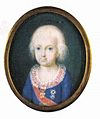 |
Naples, 6 January 1775 | 17 December 1778 | Died young from smallpox. |
| Maria Anna Giuseppa Antonietta Francesca Gaetana Teresa | 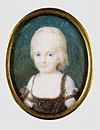 |
23 November 1775 | 22 February 1780 | Died young from smallpox. |
| Francesco Gennaro Giuseppe Saverio Giovanni Battista | 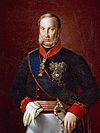 |
Naples, 14 August 1777 | Naples, 8 November 1830 | He married his cousin Archduchess Maria Clementina of Austria in 1797 and had children. He later married another cousin, Infanta Maria Isabella of Spain, in 1802 and had more children. He became King of the Two Sicilies from 1825 to 1830. |
| Maria Cristina Teresa | 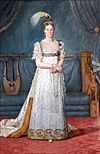 |
Caserta Palace, 17 January 1779 | Savona, 11 March 1849 | Married Charles Felix of Sardinia in 1807 but had no children. She was known for ordering excavations at Tusculum. |
| Maria Cristina Amelia | Caserta Palace, 17 January 1779 | Caserta Palace, 26 February 1783 | Died young from smallpox. | |
| Gennaro Carlo Francesco | 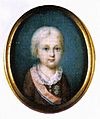 |
Naples 12 April 1780 | 2 January 1789 | Died young from smallpox. |
| Giuseppe Carlo Gennaro | 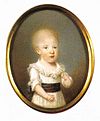 |
Naples, 18 June 1781 | 19 February 1783 | Died young from smallpox. |
| Maria Amelia Teresa |  |
Caserta Palace, 26 April 1782 | Claremont House, 24 March 1866 | Married Louis Philippe I, Duke of Orleans, who became King of the French. They had children. |
| Maria Cristina | Caserta Palace, 19 July 1783 | Caserta Palace, 19 July 1783 | Born stillborn. | |
| Maria Antonietta Teresa Amelia Giovanna Battista Francesca Gaetana Maria Anna Lucia | 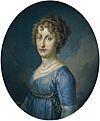 |
Caserta Palace, 14 December 1784 | Royal Palace of Aranjuez, 21 May 1806 | Married her cousin Infante Ferdinand, Prince of Asturias. She died from tuberculosis and had no children. |
| Maria Clotilde Teresa Amelia Antonietta Giovanna Battista Anna Gaetana Polcheria | Caserta Palace, 18 February 1786 | 10 September 1792 | Died young from smallpox. | |
| Maria Enrichetta Carmela | Naples, 31 July 1787 | Naples, 20 September 1792 | Died young from smallpox. | |
| Carlo Gennaro | Naples, 26 August 1788 | Caserta Palace, 1 February 1789 | Died young from smallpox. | |
| Leopoldo Giovanni Giuseppe Michele of Naples | 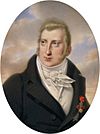 |
Naples, 2 July 1790 | Naples, 10 March 1851 | Married his niece Archduchess Clementina of Austria and had children. |
| Alberto Lodovico Maria Filipo Gaetano | 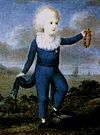 |
2 May 1792 | Died on board HMS Vanguard, 25 December 1798 | Died in childhood from exhaustion during a journey. |
| Maria Isabella |  |
Naples, 2 December 1793 | 23 April 1801 | Died in childhood. |
Royal Symbols and Coats of Arms
- Heraldry of Ferdinand of Naples, Sicily and the Two Sicilies
See also
 In Spanish: Fernando I de las Dos Sicilias para niños
In Spanish: Fernando I de las Dos Sicilias para niños



